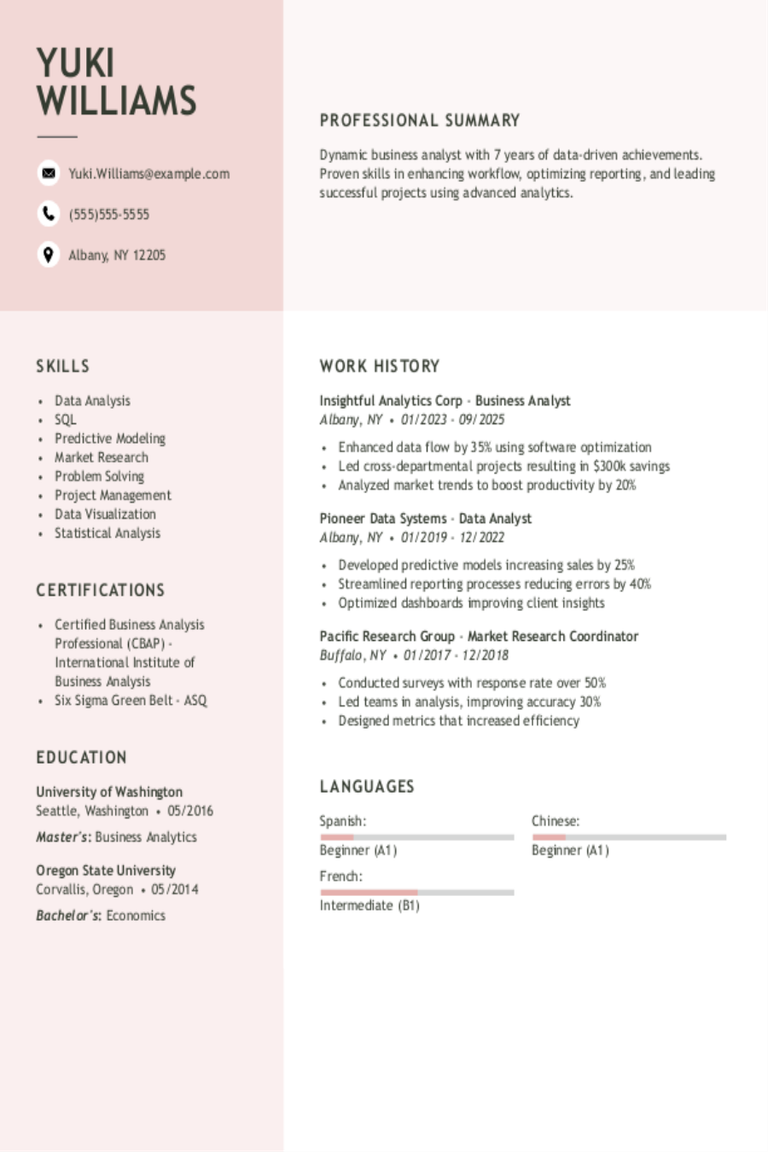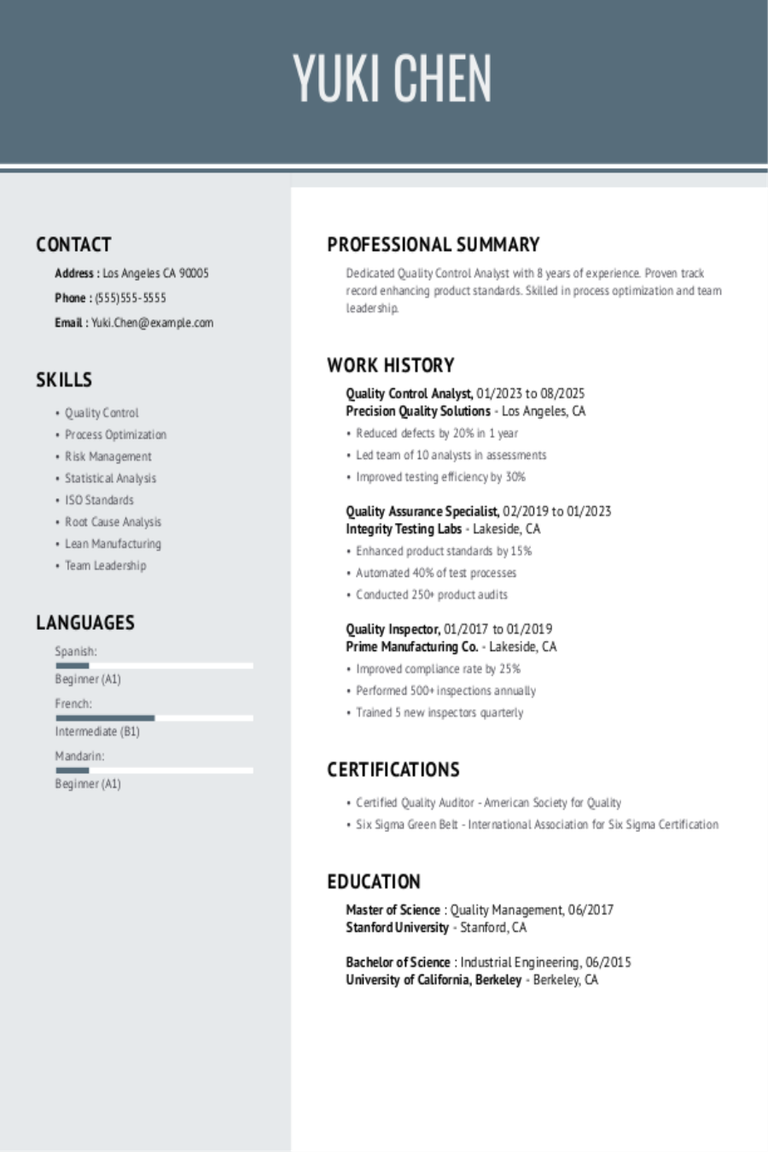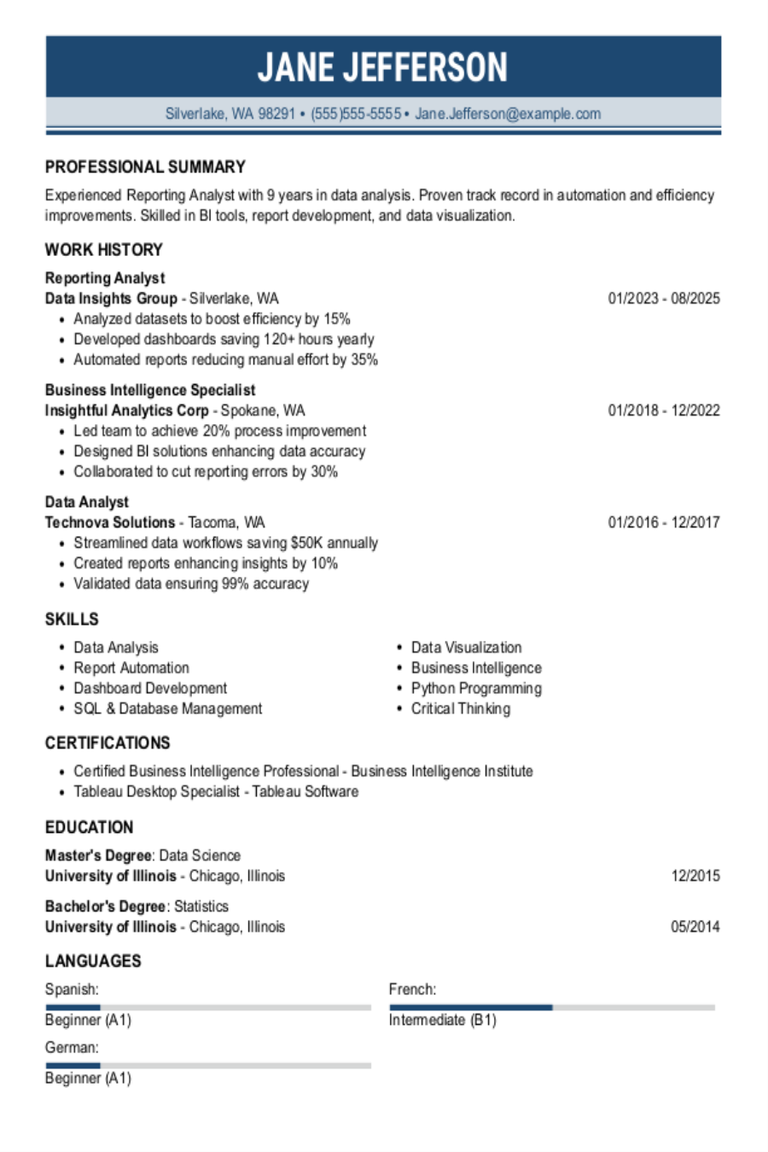Why this resume works
- Quantifies accomplishments: By pulling actual metrics like a 30% sales growth and $5k monthly cost reduction, the applicant’s resume accomplishments effectively showcase their impact and value.
- Highlights industry-specific skills: Emphasizing skills such as predictive modeling and market analysis reveals the applicant’s deep understanding of data science, perfectly aligning with roles in research and analytics fields.
- Uses action-oriented language: Strong action verbs such as “analyzed,” “streamlined,” and “improved,” convey initiative and efficiency.
More Research Analyst Resume Examples
Browse our research analyst resume examples to discover how to highlight your analytical skills, industry knowledge, and experience. These science resume samples will help you build a strong resume that effectively presents your expertise to potential employers.
Entry-Level Research Analyst
Why this resume works
- Centers on academic background: Presenting a strong education section through a master’s in data science, the applicant establishes credibility early in their career journey.
- Puts skills at the forefront: Using the skills-based resume format, skills like SQL and data visualization are immediately spotlighted, showcasing entry-level adaptability.
- Effective use of keywords: Incorporating targeted keywords such as ‘trend analysis’ ensures compatibility with applicant tracking systems (ATS), improving visibility.
Mid-Level Research Analyst
Why this resume works
- Points to measurable outcomes: Achieving measurable impacts like a 15% sales growth and $50K budget savings reveals how the applicant focuses on tangible results that drive business success and decision-making improvements.
- Demonstrates language abilities: By listing knowledge in Spanish, Mandarin, and French, the applicant leverages language skills to improve collaboration across diverse markets and cultural contexts.
- Displays technical expertise: Highlighting certifications such as Certified Data Analyst alongside expertise in statistical software demonstrates the applicant’s technical depth and readiness for data-intensive roles requiring specialized tools.
Experienced Research Analyst
Why this resume works
- Showcases impressive accomplishments: By incorporating powerful metrics like $10M revenue growth and a 25% accuracy boost, the applicant’s accomplishments stand out as senior-level achievements with measurable business impact.
- Emphasizes leadership skills: Leadership skills are evident through initiatives such as guiding a team to improve product insights by 45%, showcasing an ability to drive collaboration and deliver results.
- Sections are well-organized: Organized sections with headers and concise bullet points ensure key details like education and awards are easily scannable, making the resume both professional and reader-friendly.
Research Analyst Resume Template (Text Version)
Suki Wang
San Francisco, CA 94105
(555)555-5555
Suki.Wang@example.com
Professional Summary
Detail-oriented Research Analyst with 4 years of experience enhancing data-driven insights. Proven track record in increasing efficiency and growth with expertise in predictive modeling and market analysis. Excels in managing complex databases and delivering actionable results.
Work History
Research Analyst
Insightful Analytics Inc. – San Francisco, CA
June 2023 – August 2025
- Analyzed data to increase efficiency by 15%
- Developed monthly reports that enhanced insights by 20%
- Managed database of 10,000+ research records
Market Data Specialist
DataSphere Solutions – Lakeside, CA
January 2021 – June 2023
- Streamlined processes, reducing costs by $5k/month
- Generated insights contributing to 30% sales growth
- Maintained accuracy of 50 datasets
Business Intelligence Associate
StrategicTech Corp – Riverside, CA
September 2019 – December 2020
- Enhanced data retrieval efficiency by 25%
- Collaborated with teams improving KPI tracking by 40%
- Optimized database, reducing query time by 50%
Skills
- Data Analysis
- Quantitative Research
- Predictive Modeling
- Statistical Tools
- Data Visualization
- Market Analysis
- SQL Proficiency
- Project Management
Certifications
- Certified Data Analyst – Data Science Council
- Advanced Statistical Methods – Statistics Association
Education
Master of Science Data Science
Columbia University New York, NY
May 2019
Bachelor of Arts Economics
University of California Los Angeles, CA
May 2017
Languages
- Spanish – Intermediate (B1)
- French – Beginner (A1)
- Mandarin – Beginner (A1)
Related Resume Guides
Advice for Writing Your Research Analyst Resume
Explore our tips on how to write a resume tailored for a research analyst position, and discover how to highlight your analytical skills and passion for data-driven insights.

Highlight relevant technical skills
Technical skills are important for a research analyst role because they help you collect, analyze, and interpret data effectively. To showcase your technical skills, you can create a dedicated technical skills section on your resume.
This section should list specific tools and software you’re familiar with, such as Microsoft Excel, SQL, Python, R, and data visualization tools like Tableau or Power BI. You should also mention any statistical analysis techniques or methods you know.
Alternatively, you can integrate these skills into your work experience section. For example, when describing past jobs or projects, highlight how you’ve used different technical tools to achieve results.
Mention the software or programming languages you used and explain how they helped you complete tasks or solve problems. This approach helps employers see how your technical skills apply to real-world situations.
Commonly sought-after technical skills for a research analyst include data collection and cleaning methods, database management, statistical analysis using tools like SPSS or SAS, skill in programming languages like Python and R, and expertise in data visualization platforms. Make sure to tailor this list to match the requirements of the job you’re applying for and emphasize those that align with your strengths.
Example of a technical skills section
- Data analysis (Excel, SPSS, R)
- Statistical modeling
- Financial forecasting
- Market research methodologies
- SQL & database management
- Data visualization tools (Tableau, Power BI)
- Python for data manipulation
- Survey design & analysis
- Qualitative research techniques
Don’t forget soft skills! Teamwork, communication, and adaptability can be just as important as technical skills in many jobs. Use our Resume Builder to ensure your resume shows a balanced skill set.
Quantify your accomplishments
Measuring accomplishments in a resume transforms ordinary job details into powerful statements that showcase your impact. Instead of simply listing what you did, adding numbers and results can paint a clearer picture of your success as a research analyst.
For example, instead of saying “conducted market research,” you might say “led market analysis that increased customer engagement by 15%.” This approach highlights your achievements and lets hiring managers see the value you brought to past roles.
In the work experience section, it’s important to go beyond duties and focus on achievements. Start with your job title, employer name, location, and employment dates. Then turn tasks into accomplishments by incorporating measurable results like percentages or time saved.
Action verbs combined with metrics make your resume results-driven and compelling. By doing this for each entry, such as detailing how you improved data accuracy or reduced costs, you show potential employers exactly how you made a difference.
These quantified achievements help hiring managers quickly understand your skills and impact without having to read between the lines. They provide concrete evidence of your abilities as a research analyst, making it easier for employers to assess why you’re the right fit for their team.
5 research analyst work history bullet points
- Conducted in-depth market analysis on 120+ industries, enabling strategic recommendations that increased client ROI by 25%.
- Developed predictive financial models that improved forecasting accuracy by 40%, aiding executive decision-making.
- Streamlined data collection processes, reducing report generation time by 30% and boosting team productivity.
- Collaborated with cross-functional teams to deliver actionable insights, contributing to a 15% growth in revenue.
- Authored detailed research reports for 50+ clients, driving informed business strategies and increasing customer retention by 10%.
Need help with your resume? Check out our professional resume examples to see how others make theirs awesome and get ideas for yours.
Write a powerful professional summary
A professional summary is the opening section of your resume that introduces you to hiring managers and sets the tone for your application.
This summary highlights your experience, skills, and achievements in three to four sentences. It’s ideal for applicants with relevant job history who want to showcase their value and establish their professional identity upfront. For a research analyst, it can emphasize analytical skills, data interpretation expertise, and measurable impacts made in past roles.
In contrast, a resume objective focuses on your career goals and what you aim to contribute to an organization. It works best for entry-level applicants, those changing careers, or individuals with employment gaps. While a summary says “Here’s what I’ve accomplished,” an objective states “Here’s how I plan to help.”
Next, we’ll provide examples tailored to different industries and situations so you can confidently craft this section for your resume.
Research analyst resume summary examples
Entry-level
Recent graduate with a Bachelor of Science in economics and data analytics, equipped with foundational knowledge in statistical modeling, market research, and trend analysis. Skilled in using tools like Excel, Python, and Tableau to derive actionable insights from datasets. Eager to contribute to business decision-making through thorough research and data interpretation.
Mid-career
Research analyst with over five years of experience specializing in financial markets and consumer behavior studies. Skilled in conducting in-depth qualitative and quantitative research, developing forecasts, and presenting findings to stakeholders. Proficient in SQL, R, SPSS, and creating dashboards for performance tracking. Recognized for delivering data-driven strategies that enable revenue growth and operational improvements.
Experienced
Senior research analyst with 10+ years of expertise in guiding strategic decisions through advanced market analysis and predictive modeling. Accomplished leader skilled at managing cross-functional teams while driving large-scale projects from conception to execution. Adept at leveraging machine learning algorithms for trend forecasting and collaborating with executive leadership on high-impact initiatives. Known for achieving measurable results that align with organizational goals.
Research analyst resume objective examples
Entry-level
Detail-oriented and analytical recent graduate with a Bachelor of Science in economics, eager to join a dynamic financial firm as a research analyst. Passionate about using data analysis skills and economic knowledge to assist in strategic decision-making processes.
Career changer
Driven professional transitioning from marketing into research analysis, bringing strong skills in data interpretation and trend spotting gained through industry experience. Excited to contribute fresh perspectives and leverage transferable skills in a collaborative analytical team environment.
Recent graduate
Ambitious graduate with strong academic background in statistics seeking an entry-level research analyst position to apply quantitative reasoning and problem-solving abilities. Committed to supporting compelling projects by contributing innovative insights grounded in thorough data evaluation.
Using a resume template ensures your qualifications are highlighted effectively. Clear sections, concise formatting, and professional fonts help recruiters focus on your experience, skills, and achievements without unnecessary distractions.
Showcase your credentials
Listing certifications, licenses, and specialized training on your resume is essential for a research analyst role, especially in technical fields. These credentials show that you have specific knowledge or skills to handle complex tasks, making you stand out to employers.
A dedicated certifications section ensures these qualifications are easy to find and adds depth beyond your education section. This approach helps communicate your expertise clearly and quickly to hiring managers.
- Certified Research Analyst (CRA)
- Tableau Desktop Specialist
- Certified Business Analysis Professional (CBAP)
- Microsoft Power BI Data Analyst Associate
- Google Data Analytics Certificate
For a research analyst, certifications highlight your ability to work with tools, analyze data effectively, and deliver insights. Including industry-recognized credentials tailored to the role strengthens your application and shows you’re equipped with both foundational knowledge and up-to-date technical skills.
Example of a certifications section
Certified Research Analyst
Issued by: Global Academy of Finance and Management (GAFM)
Issued 2021
Chartered Financial Analyst (CFA)
Issued by: CFA Institute
Expires 2027
Data Analysis and Visualization with Python
Issued by: Coursera
Issued 2020
Microsoft Certified: Data Analyst Associate
Issued by: Microsoft
Expires 2026
Quantitative Research Methods Certification
Issued by: University of California, Berkeley Extension
Issued 2019
Make sure your resume stands out! Use our ATS Resume Checker to spot common errors and quickly fix them with our improvement suggestions.
Salary Insights for Research Analysts
Thinking about your future job? The U.S. Bureau of Labor Statistics shares salary info to help you see how much money you could make and what jobs are in demand. More details are provided below.
Top 10 highest-paying states for research analysts
Research Analysts earn varying salaries across the United States, with a national average of $84,407. The table below highlights the states where research analysts command the highest compensation.
Our salary information comes from the U.S. Bureau of Labor Statistics’ Occupational Employment and Wage Statistics survey. This official government data provides the most comprehensive and reliable salary information for research analysts across all 50 states and the District of Columbia. The figures presented here reflect the May 2025 dataset, which is the most recent available as of this publication.
| State | Average Salary |
|---|---|
| District of Columbia | $123,890 |
| Virginia | $122,680 |
| Alabama | $118,370 |
| New York | $117,110 |
| New Jersey | $111,990 |
| Illinois | $110,230 |
| Rhode Island | $109,570 |
| California | $108,220 |
| Maryland | $106,230 |
| Washington | $105,680 |
FAQ
Do I need to include a cover letter with my research analyst resume?
Yes, including a cover letter with your research analyst resume can increase your chances of standing out and securing interviews.
A cover letter allows you to highlight your analytical skills, discuss specific projects you’ve worked on, and demonstrate your enthusiasm for the role and company.
If the company focuses on a particular sector or methodology, mentioning any relevant experience or interest in that area shows alignment with their goals.
You might find it helpful to use a Cover Letter Generator to streamline the process. This tool ensures your document is polished and professional while saving time.
Additionally, reviewing cover letter examples can provide inspiration and guidance on structuring your own letter effectively.
How long should a research analyst’s resume be?
For a research analyst, the length of your resume can vary based on experience. Typically, a one-page resume is sufficient if you’re starting out or have less than 10 years of experience, as it helps you focus on key skills like data analysis and notable projects.
However, with extensive experience or advanced degrees relevant to research analysis, a two-page resume might be beneficial. Ensure every piece of information supports your analytical capabilities.
Explore resources on how long a resume should be to choose the best format for your career stage.
How do you write a research analyst resume with no experience?
Creating a resume with no experience for a research analyst involves emphasizing your education, skills, and relevant projects or coursework. Highlight your academic background and any research-related courses you’ve completed to improve your application. Follow these tips:
- Showcase relevant coursework and projects: Mention courses that relate to data analysis, statistics, or market research. Highlight any significant projects where you used analytical skills or tools like Excel, SPSS, or R.
- Highlight transferable skills: Focus on analytical thinking, problem-solving abilities, and attention to detail. If you’ve conducted research in an academic setting or as part of a team project, describe those experiences.
- Include internships and volunteer work: Even if not directly related to research analysis, roles that involved data handling or report generation can be valuable. Detail specific tasks and what you learned from them.
Rate this article
Research Analyst
Additional Resources

Equity Research Analyst Resume Examples & Templates for 2025
Explore equity research analyst resume samples and learn how to showcase your analytical skills and industry experience effectively.Build my resumeImport existing resumeCustomize this templateWhy this resume worksQuantifies accomplishments: By managing $5M

Business Analyst Resume Examples & Templates for 2025
Explore business analyst resume examples to see how to showcase your problem-solving, teamwork, and data skills. Browse tips to highlight your experience turning ideas into action and improving processes to

Quality Control Analyst Resume Examples & Templates for 2025
Discover how quality control analysts showcase their skills in monitoring products and ensuring standards are met. These resume examples will help you highlight your experience with testing processes and improving

Research Assistant Resume Examples & Templates for 2025
Browse research assistant resume example to see how to highlight your skills in data analysis, lab work, and collaboration. You’ll learn to showcase your experience with research projects and tools

Reporting Analyst Resume Examples & Templates for 2025
Discover reporting analyst resume examples and learn to showcase your experience in creating reports and making insights stand out to potential employers.Build my resumeImport existing resumeCustomize this templateWhy this resume

